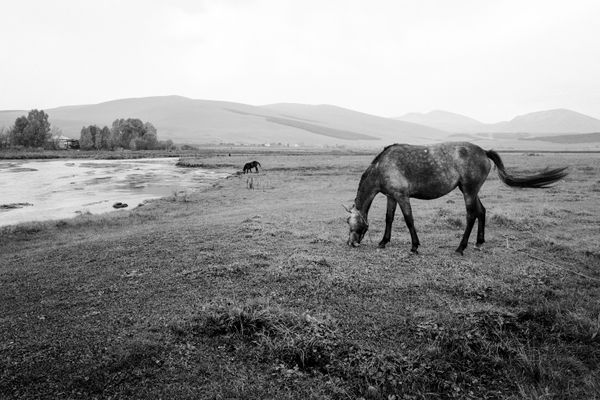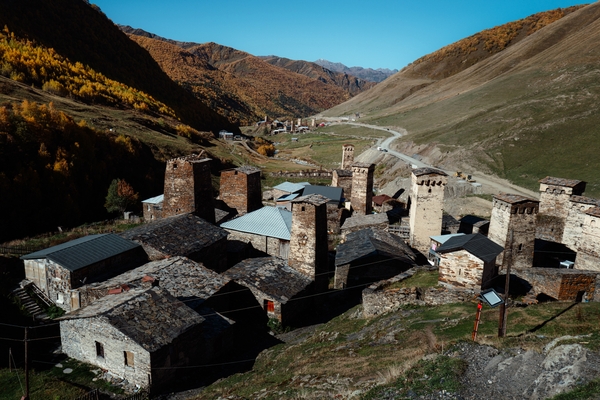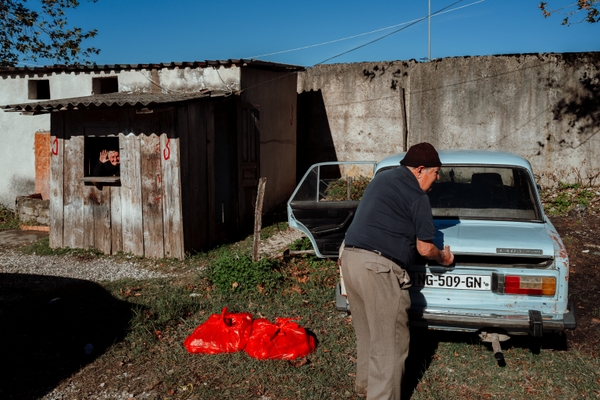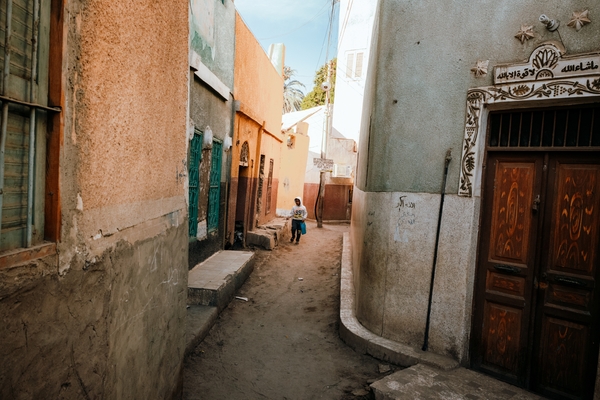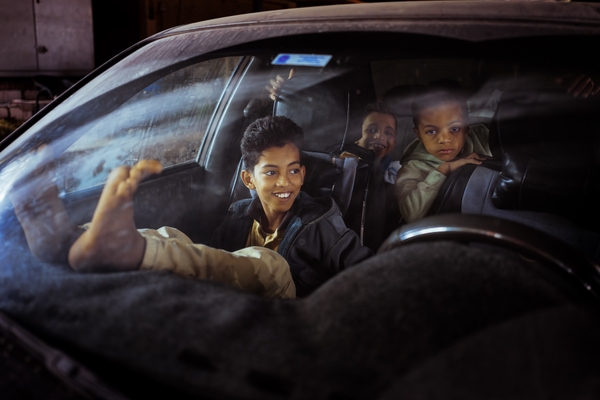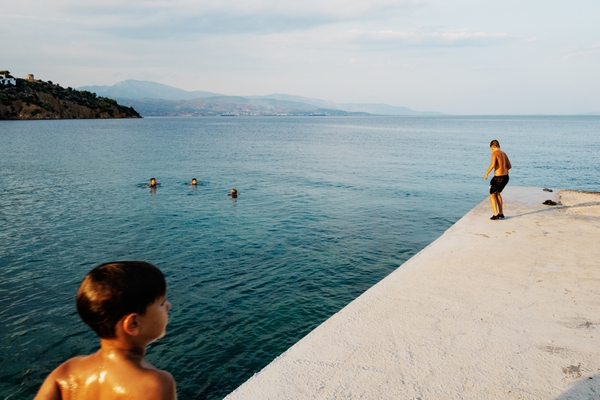Curated Series
![The Forgotten Valleys of Tsalka - Photo Series]()
January 18, 2025
The Forgotten Valleys of Tsalka
Tsalka, in Georgia’s southern highlands, is a region shaped by its diverse history and cultural roots. Once home to a mix of ethnic groups, including Armenians, Azerbaijanis, and Pontian Greeks, it has a heritage built on migration and community. The Pontian Greeks, in particular, left a significant cultural footprint, reflected in the area’s traditions and landmarks. We visited Tsalka in October 2024, under cloudy skies that seemed to reflect the mood of the region. Upon arrival, we met a Greek local and a Georgian who had grown up among the Greek community and spoke the language fluently. Exploring the area, we visited small villages with weathered homes, fields of potatoes, and cemeteries where Greek names bore Georgian suffixes, telling the story of a blended identity. The Pontian Greeks were resettled in Tsalka by the Russian Empire in the early 19th century, coming from the Ottoman-controlled Black Sea region. Despite the region’s isolation and harsh winters, the community thrived for generations, establishing schools, churches, and traditions. Over time, political changes and economic hardships prompted many to emigrate, leaving a quieter but still vibrant agricultural region behind. Documenting Tsalka through photography brought its distinct character to life. The rural landscapes, simple architecture, and reserved yet welcoming locals offered a unique insight into this historically rich part of Georgia. Tsalka remains a place tied to its roots, where stories of migration and resilience still resonate today.
![Guardians of the Past: The Svan Towers of Ushguli - Photo Series]()
December 30, 2024
Guardians of the Past: The Svan Towers of Ushguli
Ushguli, a remote cluster of villages in Georgia’s Upper Svaneti region, sits at the foot of Mount Shkhara, the highest peak in the country. It’s also known as the highest continuously inhabited village in Europe. The village is famous for its Svan towers—stone defensive structures built between the 9th and 12th centuries, a reminder of its rich history and resilience. I visited Ushguli in early October 2024 during an unusually warm autumn. The snow-capped peaks in the distance contrasted sharply with the golden fields below, creating a landscape I’ll never forget. Farming is still at the heart of life here. Everyone seemed busy—tending to their animals or working the land. Tourism has started to trickle in, but it hasn’t overtaken the community’s way of life. It’s clear that Ushguli is still deeply connected to its roots. The journey to Ushguli is easier now. Recent road improvements, like the newly paved route from Mestia and the road through the Zagaro Pass to Lentheki, make it more accessible. The drive itself is incredible—miles of untouched nature that make you want to stop and take it all in. This series is my take on Ushguli. From its people to its landscapes and timeless architecture, it’s a place I’d love to return to, maybe in a different season, to see what else it has to offer.
![Rough Hands, Timeless Traditions: The Martvili Market in Georgia - Photo Series]()
December 28, 2024
Rough Hands, Timeless Traditions: The Martvili Market in Georgia
In October 2024, I was driving from Kutaisi to Mestia, enjoying the amazing Georgian landscapes. I asked some locals if there were any markets nearby, but no one had a clear answer. Then, just outside Martvili, I stumbled upon a market by chance—and I had to pull over. The market was like stepping back in time. There was a bit of everything—livestock in one area, dairy products in another, honey and nuts nearby, and clothes hanging on makeshift stalls. The people seemed so comfortable, like this was just a natural part of their lives. What really stood out to me were their faces. This wasn’t just about buying and selling. It was a place where people gathered, shared stories, and kept their traditions alive. It reminded me of the flea markets we used to have in Greece. Most of those have disappeared or become so modernized that they’ve lost their charm. But this market in Martvili? It felt real, untouched, and connected to the people’s identity. That’s what made it stick with me.
![The Nubians - Life Between River and Sand - Photo Series]()
December 20, 2024
The Nubians - Life Between River and Sand
In late November 2024, I visited the Nubian villages near Aswan, where the Nile meets the Sahara. It’s a place where green farmland meets endless sand. The villages are different from anything I’ve seen. The roads are sandy, and the houses are painted in bright colors that make the whole area feel cheerful. I spent my time walking around, watching how people live between the river and the desert. The further I walked from the Nile, the more the desert took over—just sand, a few scattered houses, and more sand. What stuck with me the most was the resilience of the people. After being displaced by the Aswan High Dam, they rebuilt their lives and held onto their culture. Their colorful homes show how proud and creative they are. The hospitality was unforgettable. People invited me into their homes, shared stories, and showed me how they live in such a tough environment. One thing that surprised me: here, dogs are treated like family, not kept at a distance like in other parts of Egypt. This series is my way of showing their story—how they’ve created a life in a place that’s both harsh and beautiful.
![The Oasis - Resilience in Isolation - Photo Series]()
December 17, 2024
The Oasis - Resilience in Isolation
Siwa Oasis, in Egypt’s Western Desert near the Libyan border, is a place full of history and culture. Its isolation has helped preserve a way of life that feels completely unique compared to the rest of Egypt. Historically, it was called “Sekht-am,” or “palm land,” and was known for the Oracle Temple of Amon, once visited by Alexander the Great. In November 2024, I spent five days exploring Siwa, especially its lively night markets. Even though it’s remote, the markets are full of life, offering all kinds of goods. Siwa’s self-sufficiency is impressive, a reflection of how its people have kept their traditions alive despite the push of modern life. One thing I noticed was how public spaces are mostly filled with men. This is shaped by long-standing traditions and cultural norms that emphasize distinct gender roles. Women in Siwa are more involved in domestic life and private spaces, taking on key responsibilities that sustain the community. They play an essential role in areas like food preparation, handicrafts, and preserving cultural practices, though their contributions are often less visible in public life. It’s also worth noting that the practice of women wearing full veils in Siwa is relatively recent. Historically, while modesty has always been important, traditional Siwan clothing for women allowed for more individuality and was influenced by local customs rather than strict interpretations of Islamic dress. Over time, with the increasing influence of outside religious and cultural ideas, the practice of veiling has become more prevalent. This shift highlights how external influences and evolving traditions continue to shape life in Siwa, even as the community strives to maintain its unique identity. These photos aim to show what I saw in Siwa’s markets—the play of light and shadow, the local connections, and the traditions that make this oasis so special.
![Summer Secrets: The Baths of Helen of Troy - Photo Series]()
October 17, 2024
Summer Secrets: The Baths of Helen of Troy
Summer has always been an important time for me, and Loutra Oraias Elenis is where I feel most at home. This small town, named after Helen of Troy, is known for its natural thermal baths. The “Baths of Helen” stay at a steady temperature all year, making them a unique part of the area. From May to October 2024, I spent my mornings exploring the town and its surroundings. I walked through hidden paths, quiet spots, and along the coastline, trying to capture the everyday life and landscapes that make this place special. This series isn’t just about the photos—it’s about my connection to Loutra Oraias Elenis. It’s a place full of memories and simple beauty that I wanted to share through my lens.
